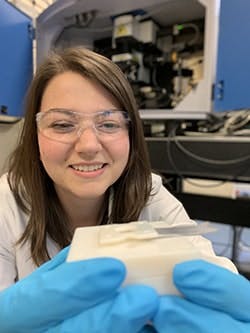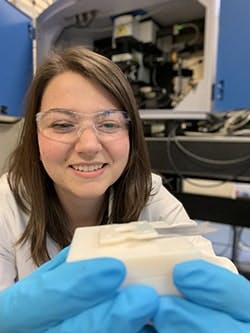Pulsed Current Boosts Water Electrolysis
Figure 1. Researcher Jessica McGlynn holds an experimental 3D-printed version. Source: Alexey Ganin/University of Glasgow school of chemistry.
A novel process almost doubles the amount of hydrogen produced per mV of electricity used during the electrolysis of water, report its developers, a team led by researchers at the University of Glasgow, Scotland.
The development follows earlier studies by the team, headed by chemistry lecturer Alexey Ganin, which found that transition metal chalcogenides (sulfides, selenides and tellurides) showed considerable promise as electrocatalysts for the hydrogen evolution reaction (HER). The researchers now have discovered that coating the electrolysis electrodes with molybdenum telluride and then applying a specific pattern of high-current pulses across them increases hydrogen production.
The team found that by cycling the current from +2 V to -0.5 V at a current density of −10 mA/cm2 (a benchmark used to compare HER electrocatalysts) the overpotential improves to 178 ±8 mV from 320 ±12 mV after only 100 cycles. This then stabilizes with no further changes seen over 1,000 cycles.
Further, optimizing the pulses of current through the electrolyte reduces by nearly 50% the amount of energy needed to make a given amount of hydrogen.
The process, described in a recent article in Nature Communications, occurs without any irreversible morphology or composition changes to the molybdenum telluride, report the researchers.
Because electric currents control the level of catalytic enhancements, Ganin believes that recent advances in machine learning and artificial intelligence (AI) could serve to fine-tune the right sequence of applied currents to achieve maximum output.
“Right now, we apply pulses and check the performance of the catalyst by measuring the potential at a given current rate: it is a trial-and-error exercise. The role of AI would be to replace this trial-and-error. We don’t have knowledge to do that yet and the aim is to find a colleague in the computer sciences department willing to help us in this endeavor,” he explains.
Investigating other catalysts is a prime focus. Theoretical chemists at universities in Germany, Portugal and Hungary also are involved in the project to better understand and predict how different catalyst structures will perform. “The priority now is to get funding to continue this work,” Ganin adds.
The researchers also are seeking funding and industrial support to develop a standard back-to-back flow cell to scale up the process.
“There has been interest from two companies so far, but we are definitely not even at intellectual property point yet. At the moment, the scale of the electrode is tiny — 1cm2 [Figure 1],” he notes.

